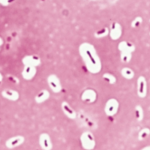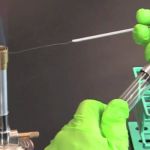There are different types of stains, namely gram stain, capsule stain, endospore stain and acid fast stain. Only acid fast stain is described in this procedure. Click on the other types of staining below to learn about them.
Introduction
The acid fast stain is a differential stain. Bacteria which are acid-fast are Gram-positive microorganisms that are resistant to the Gram stain due to the presence of mycolic acid in their cell wall, thus implementing the acid-fast stain allows us to visualize these bacteria.
Carbol fuschin serve as the primary stain. The procedure requires application of heat to ensure the stain penetrates the waxy cuticle. Acid alcohol is used as the decolourizer and the counter stain is methylene blue.
Reagents Needed
- Carbol fuschin
- Acid alcohol
- Methylene blue.
Procedures
- Prepare a bacterial smear and heat fix
- Place the slide on top of a beaker of water placed on an electric hot plate and steam for 5 minutes
- Place a paper towel on top of the smear to hold the stain in place to prevent running off
- Saturate the paper towel with enough carbol Fuchsin and allow to sit for 5 minutes, while continuously applying the stain to avoid dryness.
- Carefully remove the paper towel and allow the slide to cool
- Tilt the slide and rinse with distilled water
- Tilt the slide and rinse with acid alcohol, drop by drop until the acid alcohol runs clear
- Tilt the slide and rinse with distilled water
- Flood the slide with methylene blue and allow it to sit for 2 minutes
- Tilt the slide and rinse with distilled water
- Blot the slide dry and observe the slide under oil immersion.
References
- Keiser, G.E. ‘Laboratory manual’
- Cain, D., Hanks, H., Weis, M., Bottoms, C., and Lawson J. ‘Microbiology Laboratory Manual Biol 2421L Revised Spring Edition’
Download “Acid Fast Stain”
Acid-Fast-Stain.docx – Downloaded 0 times – 20.18 KB






